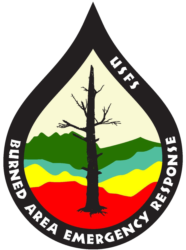Multiple agencies work with the BAER team and look at the full scope and scale of the situation to reduce the potential threats to life and property; however, BAER treatments cannot prevent all of the potential flooding or soil erosion impacts, especially after a wildfire changes the landscape. It is important for the public to be and stay informed and prepared for potential dramatic increases in number and magnitude of run-off events.
One of the most effective BAER strategies is interagency coordination with local cooperators who assist affected businesses, homes, and landowners prepare for rain events. The Forest Service and the Natural Resources Conservation Service (NRCS) work together and coordinate with local agencies and counties that assist landowners in preparing for potential run-off. It is important that landowners work directly with NRCS and other agencies to determine actions needed to protect structures and other assets.
BAER assessment plans and implementation of the BAER emergency treatments are a cooperating and coordinated effort between many federal agencies such as the Forest Service, NRCS , National Park Service, Bureau of Land Management, U.S. Fish and Wildlife Service, Bureau of Indian Affairs, U.S. Geological Survey, and National Weather Service, also including state, tribal governments, local agencies, and emergency management departments. It is important that BAER coordinates its assessment and treatment implementation with all affected and interested cooperating agencies and organizations regarding other post-fire recovery and restoration efforts.
